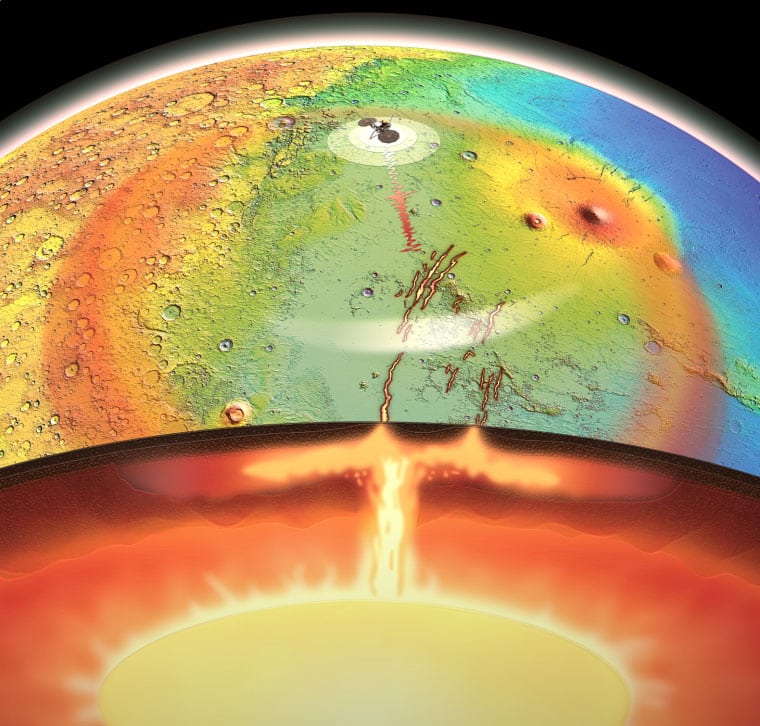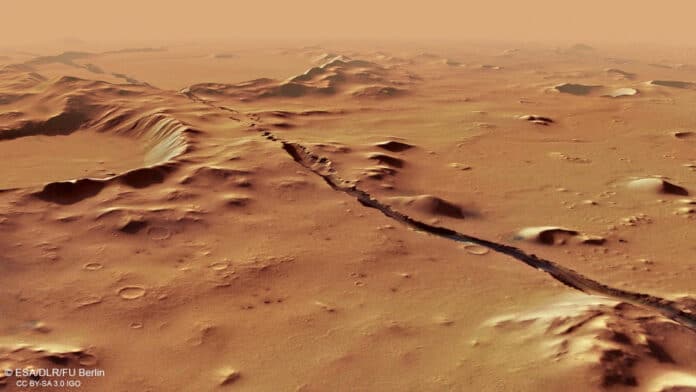Although most volcanic and tectonic activity on Mars occurred during the first 1.5 billion years of its geologic history, recent volcanism, tectonism, and active seismicity in Elysium Planitia reveal ongoing activity. However, this recent pulse in volcanism and tectonics is unexpected on a cooling Mars.
A new study by scientists from the University of Arizona presents multiple lines of evidence that reveal the presence of a giant active mantle plume on present-day Mars. The study challenges current views of Martian geodynamic evolution with a report on discovering an active mantle plume pushing the surface upward and causing earthquakes and volcanic eruptions.
Jeff Andrews-Hanna, an associate professor of planetary science at the LPL, said, “We have strong evidence for mantle plumes being active on Earth and Venus, but this isn’t expected on a small and supposedly cold world like Mars. Mars was most active 3 to 4 billion years ago, and the prevailing view is that the planet is essentially dead today.”
Adrien Broquet, a postdoctoral research associate at the UArizona Lunar and Planetary Laboratory, said, “A tremendous amount of volcanic activity early in the planet’s history built the tallest volcanoes in the solar system and blanketed most of the northern hemisphere in volcanic deposits. What little activity has occurred in recent history is typically attributed to passive processes on a cooling planet.”
The Elysium Planitia plain, located in the northern lowlands of Mars near the equator, caught the attention of scientists due to a startling level of activity. Elysium Planitia has undergone significant eruptions over the past 200 million years, in contrast to other volcanic zones on Mars that haven’t experienced significant activity in billions of years.
Andrews-Hanna said, “Previous work by our group found evidence in Elysium Planitia for the youngest volcanic eruption known on Mars. It created a small explosion of volcanic ash around 53,000 years ago, which in geologic time is essentially yesterday.”
The Cerberus Fossae, a series of young fissures that span more than 800 miles over the Martian surface, is the source of the volcanism in Elysium Planitia. Recently, the InSight team at NASA discovered that almost all marsquakes originate from this area. Although the young age of this volcanic and tectonic activity had been established, its root cause was still unknown.
Broquet said, “We know that Mars does not have plate tectonics, so we investigated whether the activity we see in the Cerberus Fossae region could be the result of a mantle plume.”

The scientists discovered evidence of a similar series of events on Mars when they examined the features of Elysium Planitia. One of the highest places in Mars’ vast northern lowlands, the surface has been raised by more than a mile. The existence of a mantle plume is compatible with the uplift being supported from deep within the globe, according to analyses of minor fluctuations in the gravitational field.
Additional measurements supported the theory that something pushed the surface up after the craters formed by revealing that the floor of impact craters is inclined in the direction of the plume. Finally, when scientists used a tectonic model to the region, they discovered that the only explanation for the extension that created the Cerberus Fossae was the existence of a massive plume 2,500 miles wide.
Broquet said, “In terms of what you expect to see with an active mantle plume, Elysium Planitia is checking all the right boxes. The finding poses a challenge for models used by planetary scientists to study the thermal evolution of planets. This mantle plume has affected an area of Mars roughly equivalent to that of the continental United States. Future studies will have to find a way to account for a huge mantle plume that wasn’t expected to be there.”
“We used to think InSight landed in one of the most geologically boring regions on Mars – a nice flat surface that should roughly represent the planet’s lowlands. Instead, our study demonstrates that InSight landed right on top of an active plume head.”
“Having an active mantle plume on Mars today is a paradigm shift for our understanding of the planet’s geologic evolution, similar to when analyses of seismic measurements recorded during the Apollo era demonstrated the moon’s core to be molten.”
Scientists noted, “Their findings could also have implications for life on Mars. The studied region experienced floods of liquid water in its recent geologic past, though the cause has remained a mystery. The same heat from the plume fueling ongoing volcanic and seismic activity could also melt ice to make the floods – and drive chemical reactions that could sustain life deep underground.”
Andrews-Hanna said, “Microbes on Earth flourish in environments like this, and that could be true on Mars, as well. The discovery goes beyond explaining the enigmatic seismic activity and resurgence in volcanic activity. Knowing that there is an active giant mantle plume underneath the Martian surface raises important questions regarding how the planet has evolved. We’re convinced that the future has more surprises in store.”
Journal Reference:
- Broquet, A., Andrews-Hanna, J.C. Geophysical evidence for an active mantle plume underneath Elysium Planitia on Mars. Nat Astron (2022). DOI: 10.1038/s41550-022-01836-3
